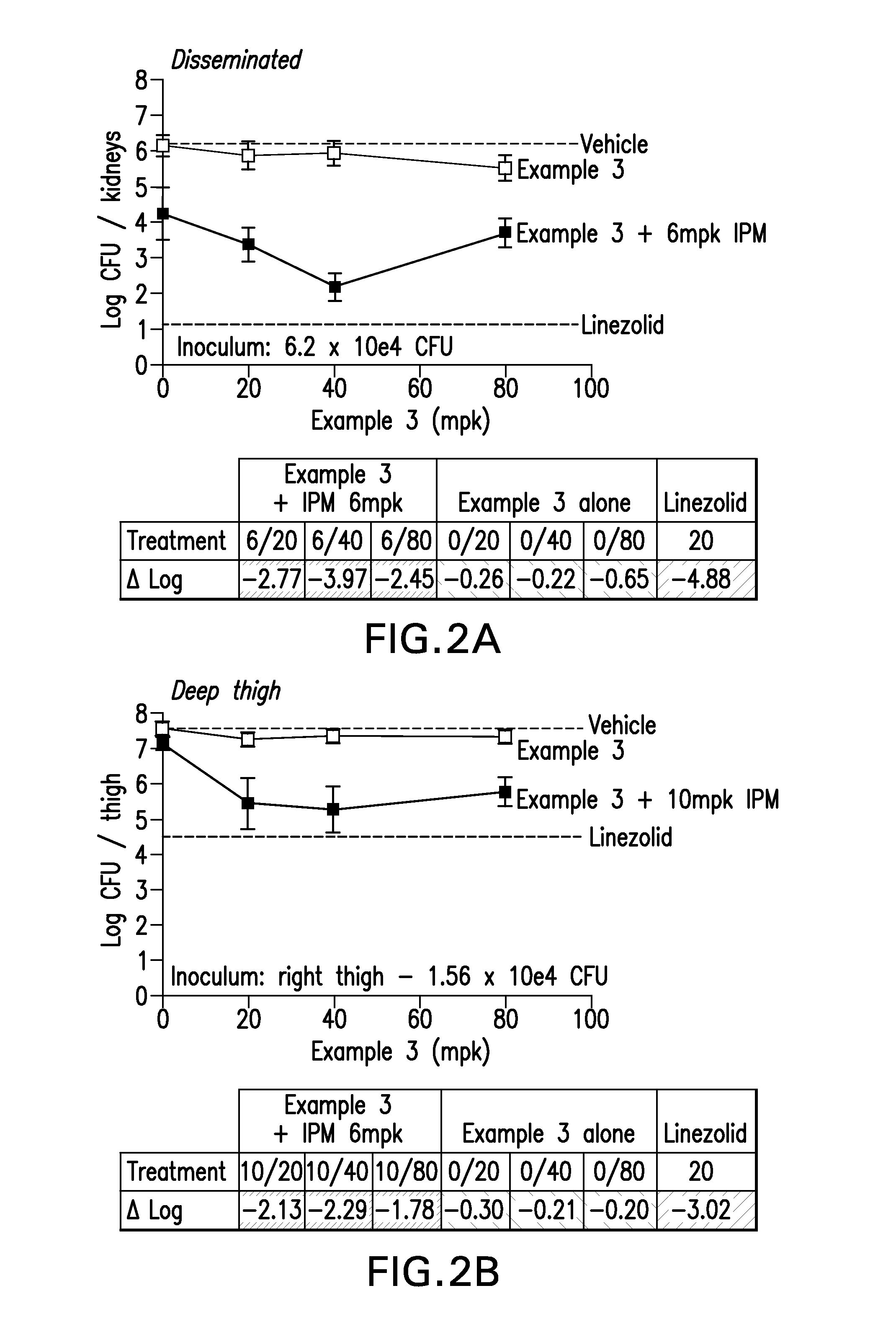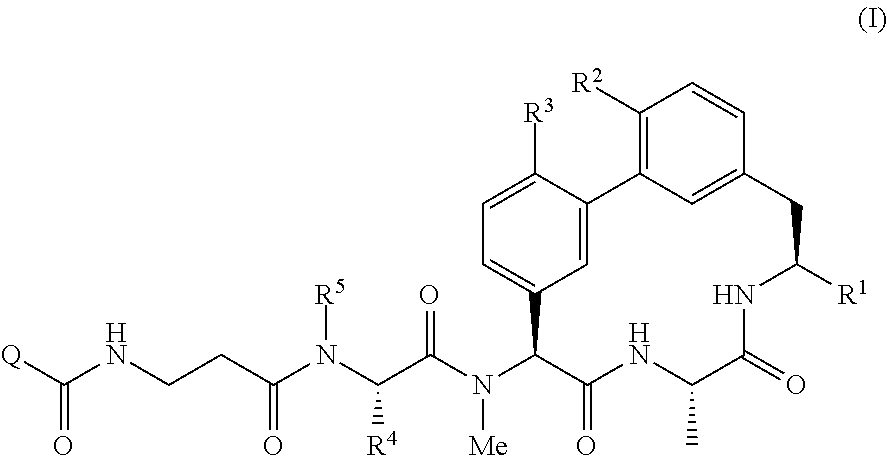Bridged lipoglycopeptides that potentiate the activity of beta-lactam antibacterials
a lipoglycopeptide and beta-lactam technology, applied in the field of bridged lipoglycopeptides, can solve the problems of major drug resistan
- Summary
- Abstract
- Description
- Claims
- Application Information
AI Technical Summary
Benefits of technology
Problems solved by technology
Method used
Image
Examples
example 1
Method B
6-[[(7S,10S,13S)-13-carboxy-3,18-dimethoxy-10-methyl-8,11-dioxo-9,12-diazatricyclo[13.3.1.12,6]icosa-1(19),2(20),3,5,15,17-hexaen-7-yl](methyl)amino]-6-oxo-5-[(3-{[(4′-propylbiphenyl-4-yl)carbonyl]amino}propanoyl)amino]hexan-1-aminium trifluoroacetate
[0225]
Step 1: methyl(2S)-2-[(3-{[(benzyloxy)carbonyl]amino}propanoyl)amino]-6-[(tert-butoxycarbonyl)amino]hexanoate
[0226]To a solution of methyl(2S)-2-amino-6-[(tert)-butoxycarbonyl)amino]hexanoate hydrochloride (7 g, 23.6 mmol) in 40 mL of DMF were added HATU (10.76 g, 28.3 mmol), 3-{[(benzyloxy)carbonyl]amino}propanoic acid (6.32 g, 28.3 mmol) and then DIPEA (12.36 ml, 70.8 mmol). The resulting solution was stirred for 18 hrs and then partitioned between saturated aqueous solution NaHCO3 and EtOAc. The two phases were separated and the aqueous layer was extracted twice with EtOAc. The combined organic phases were washed with water (2×) and brine, dried over Na2SO4 and concentrated under reduced pressure. Purification by ISCO (...
example 2
Method B
5-(R,S)-6-[[(7S,10S,3S)-13-carboxy-3,18-dihydroxy-10-methyl-8,11-dioxo-9,12-diazatricyclo[13.3.1.12,6]icosa-1(19),2(20),3,5,15,17-hexaen-7-yl](methyl)amino]-6-oxo-5-[(3-{[(4′-propylbiphenyl-4-yl)carbonyl]amino}propanoyl)amino]hexan-1-aminium trifluoroacetate
[0233]
[0234]To a suspension of 6-[[(7S,10S,13S)-13-carboxy-3,18-dimethoxy-10-methyl-8,11-dioxo-9,12-diazatricyclo[13.3.1.12,6]icosa-1(19),2(20),3,5,15,17-hexaen-7-yl](methyl)amino]-6-oxo-5-[(3-{[(4′-propylbiphenyl-4-yl)carbonyl]amino}propanoyl)amino]hexan-1-aminium trifluoroacetate (EXAMPLE 1) (1.10 g, 1.136 mmol) in 20 mL of 1-propanethiol was added portionwise AlBr3 (4.70 g, 17.60 mmol). The resulting mixture was stirred at 50° C. for 1 hr and was then cooled to room temperature. Water was carefully added to quench the reaction and the white solid was filtered. The filtered cake was washed with water and it was dried by aspiration. The crude solid was purified by flash column chromatography on Lichoprep RP-18 eluting wi...
example 3
Method C
(5S)-6-[[(7S,10S,13S)-13-carboxy-3,18-dihydroxy-10-methyl-8,11-dioxo-9,12-diazatricyclo[13.3.1.12,6]icosa-1(19),2(20),3,5,15,17-hexaen-7-yl](methyl)amino]-6-oxo-5-[(3-{[(4′-propylbiphenyl-4-yl)carbonyl]amino}propanoyl)amino]hexan-1-aminium trifluoroacetate
[0235]
[0236]The procedures described below (Method C) for the synthesis of EXAMPLE 3 avoids the epimerization of the lysine residue.
Step 1: methyl 3-{[(4′-propylbiphenyl-4-yl)carbonyl]amino}propanoate
[0237]To a solution of amine β-Alanine methyl ester hydrochloride (2.67 g, 19.1 mmol) in DMF (30 mL) were added HATU (7.28 g, 19.1 mmol), 4-(4-n-propylphenyl)benzoic acid (2.30 g, 9.6 mmol) and DIPEA (6.69 ml, 38.3 mmol). The solution was stirred at room temperature for 4 days. The reaction mixture was diluted with water and the resulting precipitate was filtered. The filtered cake was washed with water and dried under vacuum to afford the desired material (3.11 g, 100%).
Step 2: 3-{[(4′-propylbiphenyl-4-yl)carbonyl]amino}propio...
PUM
| Property | Measurement | Unit |
|---|---|---|
| Time | aaaaa | aaaaa |
| Density | aaaaa | aaaaa |
| Electrical resistance | aaaaa | aaaaa |
Abstract
Description
Claims
Application Information
 Login to View More
Login to View More - R&D
- Intellectual Property
- Life Sciences
- Materials
- Tech Scout
- Unparalleled Data Quality
- Higher Quality Content
- 60% Fewer Hallucinations
Browse by: Latest US Patents, China's latest patents, Technical Efficacy Thesaurus, Application Domain, Technology Topic, Popular Technical Reports.
© 2025 PatSnap. All rights reserved.Legal|Privacy policy|Modern Slavery Act Transparency Statement|Sitemap|About US| Contact US: help@patsnap.com



